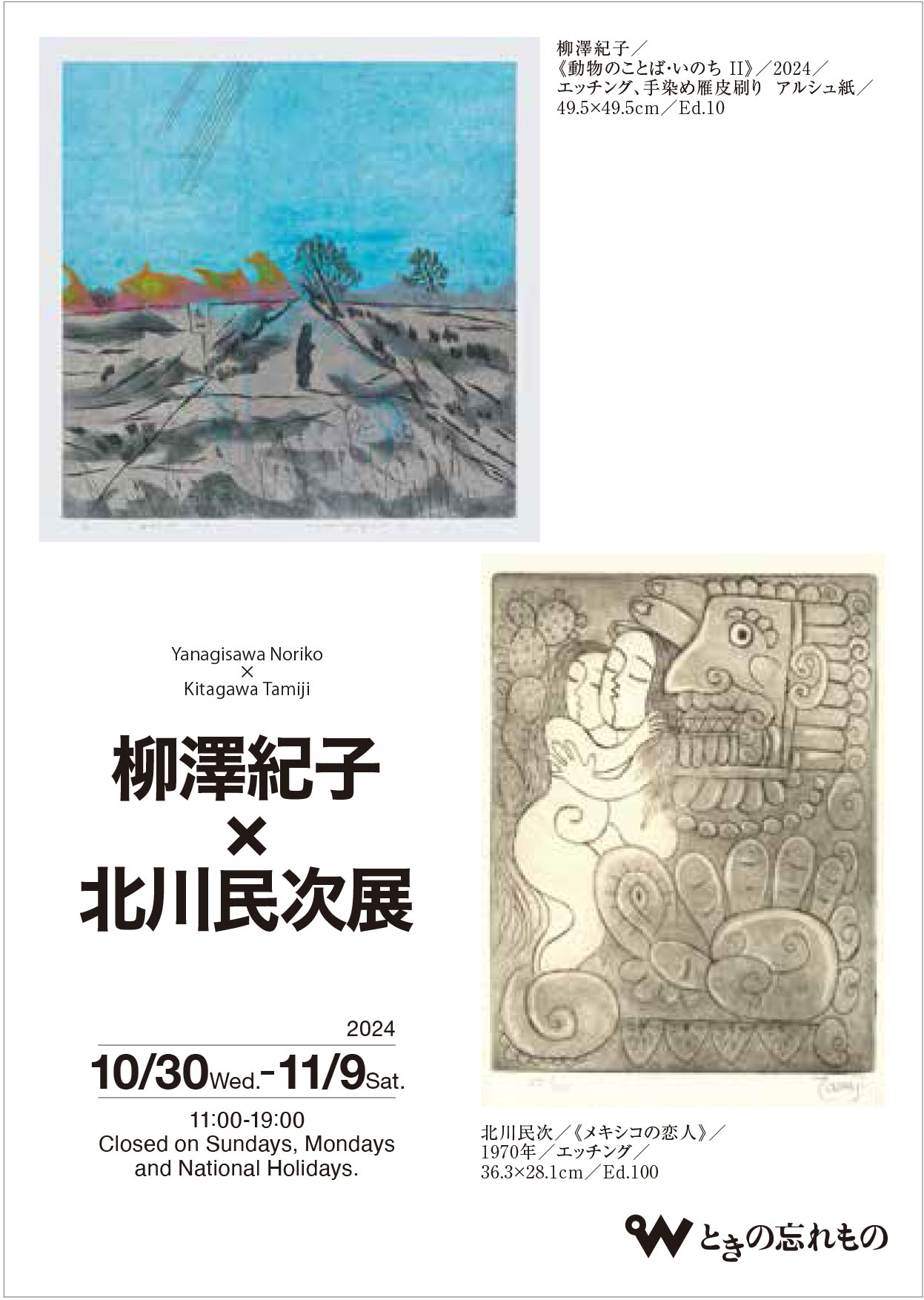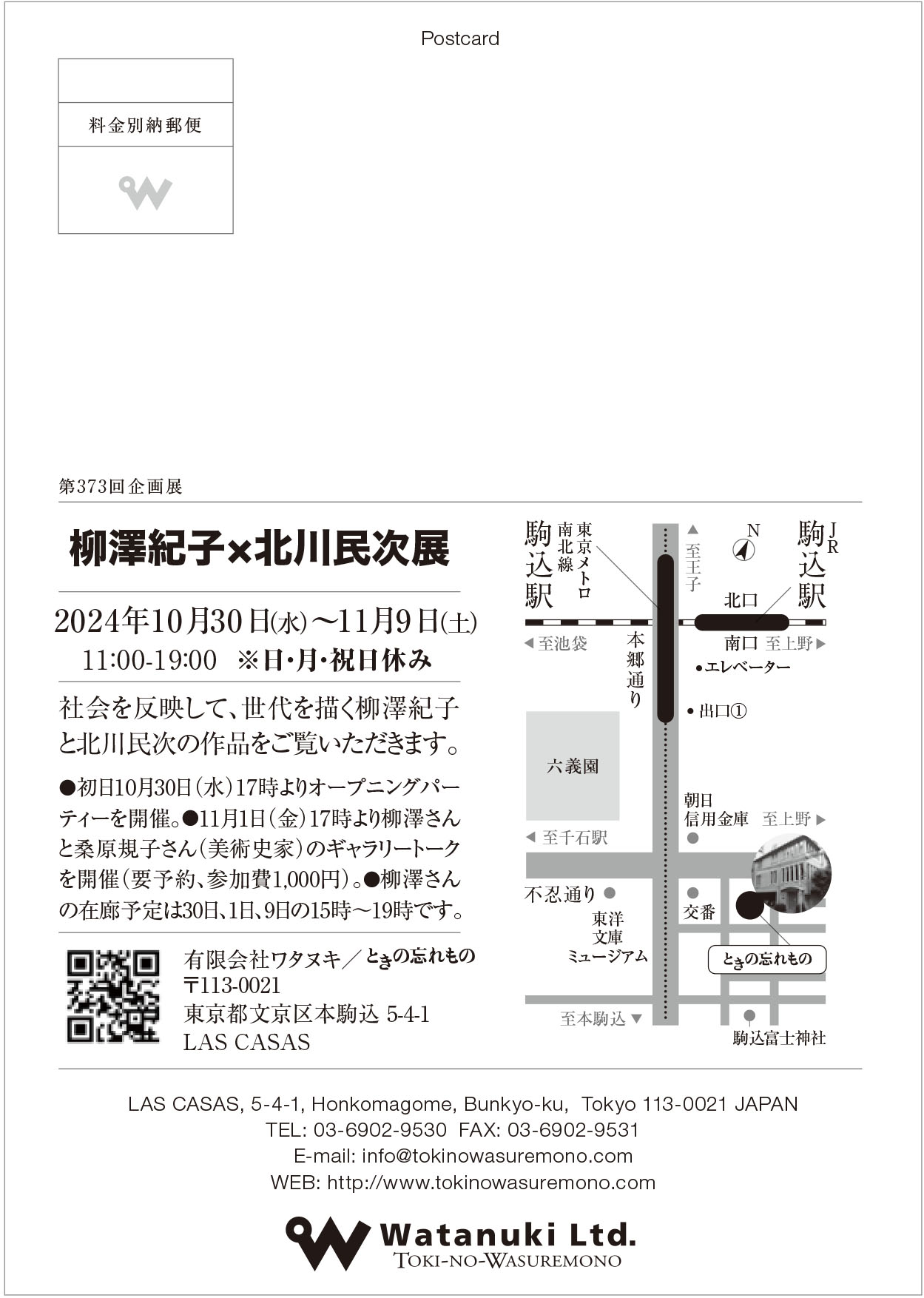Noriko Yanagisawa and Tamiji KitagawaSchedule: October. 30 [Wed.] - November. 9 [Sat.] 2024
|
  *Click images to view in original size |
The artist and printer Yanagisawa Noriko is from Hamamatsu city in Shizuoka prefecture, currently creating artworks based on Kakegawa city. Yanagisawa, who has been staring at humans and observing nature, creates works with strong images of the relationship between humans and nature, especially animals, works dealing with the relationship between humans and scientific technology such as nuclear power plants, and works that attempt to delve deeply into the inner world of humans using a motif of body.
She studied at Tokyo University of the Arts under the teachings of Komai Tetsuro and had expressed herself in copperplate print. Since around 1995, she has been deepening her expression by using mixed media, and through her works, she has been asking questions to many people beyond race, generation, and gender.
The Western-style painting artist Kitagawa Tamiji was born in Kanaya in Shizuoka prefecture as well. He moved to the U.S. in 1914 and then to Mexico in 1921, where he created works with a unique style that depicted the Mexican climate and people, and also acted as an art educator.
The art critic Kubo Sadajiro became his actual publisher and produced nearly 400 of his prints during his lifetime. This year, the 130th anniversary of his birth, the first large-scale retrospective exhibition in about 30 years, “Kitagawa Tamiji Retrospective: From Mexico to Japan” (Nagoya City Art Museum, Setagaya Art Museum, Koriyama City Museum of Art) is being held.
In this exhibition, we will present more than a dozen works by each of these two artists, who reflect society, depict their generation, and have shown many of their works abroad.
■Noriko YANAGISAWA
Born 1940 in Hamamatsu City, Shizuoka. Graduated from Hamamatsu Municipal Senior High School, and from Tokyo University of the Arts Oil Painting Graduate Program in 1965. Studied oil painting under Hayashi Takeshi as an undergraduate, and studied copperplate printing from Komai Tetsuro during her graduate program. This was the golden age of Komai's classroom, which produced such talents as Nakabayashi Tadayoshi, Noda Tetsuya, and Hara Takeshi. In 1964, was awarded the Japan Hanga Association Award. Went to the United States in 1964 and stayed for four years. Created works at the New York Printmaking Workshop. After returning to Japan, based herself in Kakegawa City, Shizuoka, and continued her work, primarily making copperplate prints from etchings. 1983, had a two person show at Ikeda Musem of 20th Century Art. 1984, published a collection "To the sea" with poems by Okada Takahiko (Gendai Hanga Center).
2001, awarded the 10th Yamaguchi Gen Award. Has held solo exhibitions around the world in places including World Bank Art Society (Washington DC), the National Gallery of Bulgaria, Tikotin Museum of Art (Israel), the National Museum of Art of Romania, Pinacoteca de São Paulo (Brazil), Kakegawa City Ninomaru Art Museum, and Hillside Forum. Yanagisawa's work pursues "the relationship between body and spirit"; images like ammonites and wings, ships, water, and trees layer onto the drawn body; the work resonates with diverse themes such as man and nature, civilization, and time. She actively approaches new works such as "test-zone", with the theme of nuclear technology, as well as large scale mixed media works using washi paper. She taught at Musashino Art University from 2003-11.
■Tamiji KITAGAWA
Born 1894 in Shizuoka, Japan. Dropped out from the Waseda University in 1914, He moved to the USA and studied with Yasuo KUNIYOSHI under John Sloan at the Art Students’ League. He moved to Mexico in 1923, becoming friends with artists such as David SIQUEIROS and Diego RIVERA, and participating in Mexican Renaissance movment. He also worked on children’s art education at Tlalpan. In 1931 moves outdoor art school to Taxco and became a head master. Returned to Japan in 1936.
Gained attention at the 29th Nika Exhibition in 1937 with “Festival at Taxco” and other works.His unique style of works expressing cultures and people of Mexico has made many fans and were highly rated in Nika Exhibitions and Japan International Art Exhibitions. He became the President of Nika-kai in 1979, but left within the same year. Passed out in 1989 at Seto.
|
Movie production: Web Magazine CollaːJ SHIONO Tetsuya
|
 | |
 | |
 | |
 | |
 | |
 | |
 | |
 | |
 | |
 | |
 | |
 | |
 | |
 | |
 | |
 | |
 | |
 | |
 | |
 | |
 | |
 | |
 | |
 | |
 | |
 | |
 | |
 | |
 | |
 | |
 | |
 | |
 | |
 |


